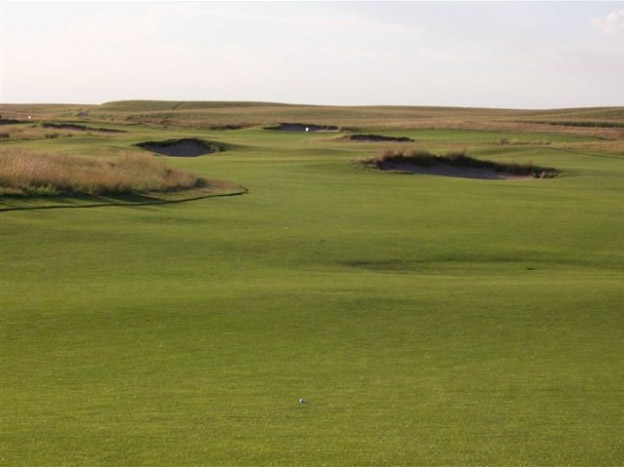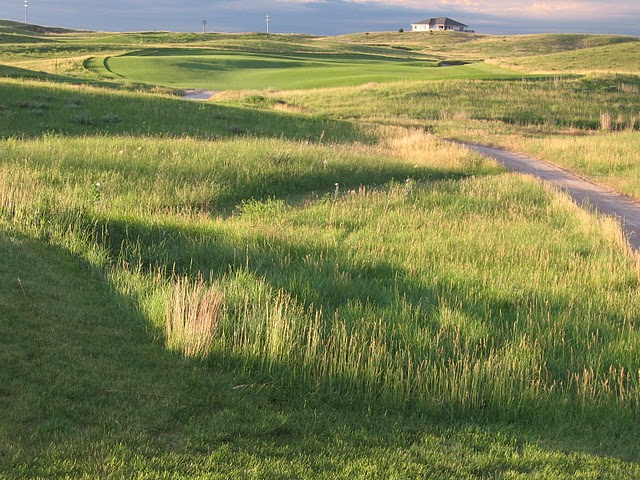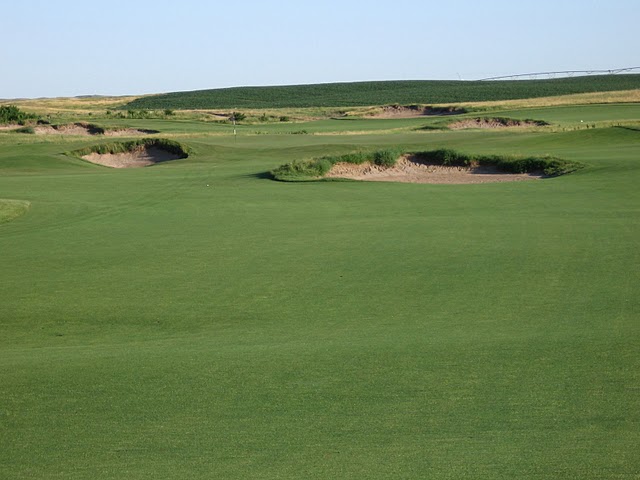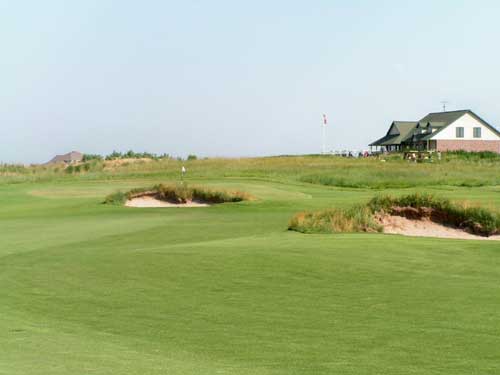
This is the story of how a few people in a very small town in the middle of Nebraska, who just wanted a new place to play golf—hopefully 18 holes, maybe a little nicer than the old 9-hole course the next town over—ended up with one of the greatest courses in America.
Gothenburg, with a population of around 3,600, is a sleepy farm and ranch town in the plains of Nebraska that sits along I-80 and the Union Pacific rail line, both of which are laid over the top of the old Pony Express mail route. It’s just about the last place you’d expect to find a golf course the caliber of Wild Horse Golf Club, which Golf Week rates among the 30 best built in America after 1960.
Laudable courses are one thing. Golf courses that inspire pilgrimage from devoted followers is another, and on any given day in the summer at Wild Horse you’re likely to encounter among the regular Gothenburgers enthusiasts who have traveled from across the country and beyond to play it.
As small and remote as Gothenburg is, however, it’s not nearly as small and remote as Mullen, Nebraska, two and a half hours to the north, and it’s in Mullen that the story of Wild Horse begins.
Mullen, of course, is the address of Sand Hills Golf Club, although the course is actually about 12 miles away as the crow flies. For those that don’t know, Sand Hills was built in the mid-1990’s for Lincoln-based developer Dick Youngscap by Bill Coore and Ben Crenshaw. “Discovered” might be more an apt term—the architects found holes that essentially already existed in the vast landscape of wrinkled sand dunes, moving hardly any earth to formalize them and only minimally crafting the greens and bunkers.
Working on the project with Coore and Crenshaw, as they frequently have throughout their careers, were two experienced shapers from Texas, Dan Proctor and Dave Axland, who also operate their own small design-build firm called BunkerHill Golf Inc.
Almost from the moment Sand Hills opened in 1995 it was regarded as one of the best and certainly most atmospheric courses in the U.S. (Golf Week rates it the best modern course in America). Photos immediately began appearing in magazines while tales of it stirred imaginations worldwide, all the while giving Nebraskans, who had probably never thought much if at all about the thousands and thousands of square miles of desolate sand hills that comprise the northwest section of the state, another source of state pride beyond just Cornhusker football.
About this same time back in Gothenburg, a small group of avid players—perhaps sensing the fever of golf in the Sand Hills but in no way imagining anything of the sort for themselves—formed Gothenburg Links Inc., to begin the process of developing their own new course.
Several members of the development group played at the nine-hole course in Cozad, 12 miles down the highway, and their goals for the new course were modest: build a better course than that one, and if possible, make it 18 holes. First they needed to find a site, and one of the partners knew of some pastureland a few miles northwest of Gothenburg. Soon the group began the process of cobbling together enough money to acquire it.
At this point in the process the group was talking to architect Marty Johnson, who worked out of Sioux City, Iowa and was something of a specialist in design and renovation work for small town courses throughout the plains region. One of the partners in the group, however, knew Dick Youngscap (who also developed Firethorn Golf Club in Lincoln) and put in a call to see whom else he might recommend to design their course.
Given Gothenburg’s location and modest budget, Youngscap suggested they talk not to Coore and Crenshaw but rather to Proctor and Axland, the two primary shapers at Sand Hills.
“ Dave and I were working down in Arizona at Talking Stick (another Coore and Crenshaw design), and Dick Youngscap called Dave and said, ‘There’s some people in Gothenburg that want to build a golf course, and I told them about you guys.’” Dan Proctor remembers.
“Anyway,” he continues, “we were busy working our tails off, and about a month went by and Dick called back and said, ‘You all need to get up there. These guys are going to choose Marty Johnson if you don’t.’”
When Axland and Proctor finally did make the trip back to Nebraska in the fall of 1996, they were nearly flabbergasted by the land the group was in the process of purchasing.
“I didn’t expect much because I knew the area fairly well,” Proctor says, “but about two miles north and a mile west there’s a little section of ground about 400 acres that looked as if it had been chunked off the edge of the Sand Hills, and it had always been pasture ground because it was kind of severe for farming.

Though not as dramatic as Sand Hills, the Wild Horse property had everything necessary to build an affordable, world class golf course.
“So we drove out there and immediately it just changed our whole attitude about what they had for land there. Dave and I just looked at each other and said, ‘Man this looks good.’”
The Wild Horse property was an unbroken ranch covered in fescue and native prairie grass. An endless array of ripples and subtle movements animated the earth, and on the south side, drifting up toward the center of the site where the clubhouse now stands, were steeper hills and gullies. It was neither as dynamic nor dramatic as Sand Hills, but in other ways it was just as good a piece of land for golf. More importantly, Proctor and Axland knew they could build a fun, natural 18-hole course on it and for not a lot of money. What they weren’t immediately sure of, however, was if the investment group could raise even as much as $1 million.
When they were able to secure the property and develop the budget, Axland and Proctor were hired for a modest fee and monthly salary, and construction commenced in the spring of 1997. Because they performed most of the construction themselves and chose not to move much land in the process they were able to build the holes cheaply and efficiently.
They had a scraper on site for just one week, using it one day to soften the second shot at the par five sixth (a lovely hole that features the most elevation change on the course) and again for a day and a half massaging the par five third. The rest of the time it was used on the driving range, while everything else was left alone or done by smaller equipment. They excavated the area below the clubhouse for the parking lot and used that material to build up the greens.
Proctor estimates the entire cost, including the clubhouse and maintenance building, was under $2 million, though he says he’s never seen the exact figures. “But I know the golf course didn’t cost much more over $1 million (to build).”

The size and speed of the ultra-firm fairways separate Wild Horse from virtually all other courses on the Plains.
Wild Horse is worth looking at closely today because it’s a prime example of how to build a world-class golf course for not the usual $10 million or more. Land costs vary—and 300 acres in most places costs more than a horse pasture does outside Gothenburg—but the construction costs to build a course don’t have to be anywhere near that expensive if approached with restraint and an emphasis on strategy rather than showmanship.
Of course the beauty of Wild Horse is not just the minimal cost to build it, although that up-front affordability trickles down to everyone who play it (rates range from $35.50 to $41 for walkers, and a peak price of $54 that includes a cart).
The beauty is also, well, its beauty. That’s assuming you love to see prairie grasses swaying in the wind, distant vistas across a spectrum of holes that subtly rise and fall over natural ground, chunky fescue-lined bunkers that look imported from Sand Hills (though built on a smaller scale) and a tight, swirling routing perfect for walking with pedestrian dew trails cut and trampled through the native.
The golf at Wild Horse matches the naked, windy site. Broad fairways bump and bend slightly from the tee, like at the tough par four second that gives players a chance to cut across a deeper expanse of prairie to shorten the approach to an unnerving un-bunkered green, or the uphill 18th with the advantage going to the player who can take the drive up the longer right side. The short par four 15th, despite the width of the fairway, rewards only longer and more imperiled drives hit far down the left side by yielding an open look at the tiny, angled putting surface.
As the holes progress at Wild Horse, strategy becomes more important, the bunkers become more numerous and the risk/reward options increase. The round builds to a crescendo. Proctor and Axland say this wasn’t necessarily planned but was the result of timing and fortitude, or lack of it.
The second nine was constructed first, “And for various reasons when we got around to the front nine we didn’t have as many bunkers,” Proctor says, “partly because we had run out of time and we were worn out. And we thought, ‘Maybe we don’t need as many bunkers.’”
“If we’d have done the front nine first,” he says, “we might have gotten a little carried away and it wouldn’t have built up like it does.
If there’s one trait that sets Wild Horse apart from most prairie courses, no matter how thoughtfully designed, it’s the slick bluegrass playing surfaces. The ground game here is not just discussion board fantasy—the ball bounces and rolls, and you can actually hit running shots onto the generous and generally open green fronts. When the wind is up it’s sometimes not only an option but a necessity.
The lesson in all this is that less is often more; economic sensibility and artistic (and strategic) achievement are not mutually exclusive. Both can bring profits if executed intelligently. Because the initial costs were reasonable and sensible, the debt service is or is near to being paid off with the course hosting in the neighborhood of 25- to 30,000 rounds a year.
Begin with a good piece of land—it doesn’t have to be Sand Hill-type terrain, just something uncompromised with a little natural movement—cut out the superfluous accoutrements, and, perhaps most importantly, hire the right architect.
In the case of Wild Horse it was a design/build firm that eliminated middlemen, organizational bureaucracies and paperwork. Proctor and Axland executed an efficient, hands-on build that minimized cost and unnecessary expenditure—their holes speak loudly and don’t need additional ornamentation. [An architect who uses a regular skeleton crew of shapers could achieve the same goal; see: Coore and Crenshaw.]
“I like to tell people that if they’d have had $3 million there’d have been 40 companies up there trying to do that project,” Proctor says. “But it was a blessing to us because they didn’t have much money to start and only had to deal with Marty and us.
“And that’s the beauty of the small town market…you can hit a home run because their expectations are so low. That’s the way it was there—their expectations were low…and we knocked ‘em over with what we created.”
Expectations don’t have to be low, but if more developers followed the small town prescription, certainly more expectations would be met. (94)
Wild Horse Golf Club
Gothenburg, NE
308-537-7700
GET HERE
Gothenburg is a 4 1/2 hour drive from Denver International Airport, and a three hour drive from Lincoln. Flights are also available from Denver to North Platte, just over 30 minutes west of Gothenburg.
STAYING
Options are limited, but if you’ve made the journey this far you’ll be playing 36 holes a day and won’t need much more than a bed and A/C. The Super 8 just off I-80 at exit 211 is your best bet (they’re used to hosting out of state players), and there’s also a few more options in Cozad, 10 miles away.
DINING
If you’re not familiar with Nebraska you might not have heard of Runza, a fast food chain. They offer the traditional in and out burger fare but specialize in runzas, a dough pocket filled with cooked meat and cabbage that originated in Russia but remains popular in certain areas in the plains and Midwest.
Another more relaxed option is Walker’s Family Steak House on Route 30 just a few minutes from the Super 8. Walker’s is a casual and friendly but almost kitschy restaurant that occupies a large room that’s divided into the restaurant on one side and a stage and dance floor on the other. The prime rib is fantastic and it’s a perfectly imperfect place to reload on carbs, protein and beer.


